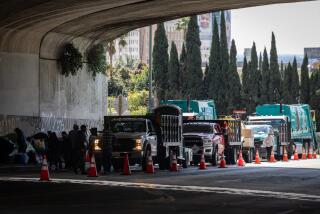Opinion: Counting the homeless on the streets of East L.A.
As Claudia Chaparro drives her car toward the census tract in East L.A. where we will begin counting homeless people, her sister, Victoria Covarubbias, points to a man sitting on a sidewalk. “Do people on our way count?” she asks.
They don’t. The Los Angeles Homeless Services Authority, which organizes the count, has divided the county into different areas to be surveyed Tuesday, Wednesday and Thursday nights. At deployment centers in each area, volunteers are handed maps with specific census tracts painstakingly outlined and told to count within the lines.
I’m along for the ride with a team of three counters -- Claudia, Victoria, and an Occidental College freshman, Ava Gempler, who’s doing an assignment for her urban and environmental policy class. We’re trailed by a local TV news van. The first night of the count, in particular, brings a lot of media attention. Which is fine, if a bit bizarre for homeless people who otherwise are generally ignored or shooed away from doorsteps and sidewalks.
We park near Saybrook Park and set off across the grass, the TV news cameraman’s lights illuminating the way. It is ghostly quiet except for a train whistle in the distance. Two cats skitter across Saybrook Avenue.
Out of the park and on a quiet side street, one of the sisters spots an RV. “Someone for sure lives here,” says Claudia, looking at the silvery material on the vehicle. “The foil keeps the cold away.”
The news cameraman peels off for other parts. We make our way to Whittier Boulevard, passing small stores, fast-food restaurants and brightly lighted taco trucks every other block. Claudia, who works for the county’s Department of Public Social Services, sees people every day on the verge of homelessness. “I have clients come in and I think, man, I wish I could take them home. Do you know how hard it is to have a woman who’s a victim of domestic violence with a kid and I have to tell her I have nowhere for them to go?” she says. She makes the calls to different places that will take someone in that situation and, too often, “they say, ‘Nothing’s available. No space.’ I say, ‘Don’t give up.’”
Victoria sees a woman huddled in a dark doorway across the street. Is she homeless? None of us can tell. We scurry across the expanse of Whittier Boulevard for a closer look. As soon as we get to the other side, we see she is talking on a cellphone and looks perfectly … not homeless.
Much of this counting involves close scrutiny — people have a way of ingeniously hiding themselves in corners — and judgment. It’s better than not counting, but this is an estimate at best.
A homeless person sleeps under a blanket in front of a bank, oblivious to the four of us who have stopped in front of him -- two with clipboards, one with a reporter’s notebook, all jotting down notes.
In front of a Department of Public Social Services office on Whittier, we count three people. They have fashioned individual refuges out of cardboard, tarps and various flotsam and jetsam. One person has placed an open umbrella on the ground as a barrier against the cold. Claudia approaches one man and quietly speaks to him in Spanish. They chat, and she shakes his hand before leaving. “He said people bring him food,” she says.
By 11 p.m. we have finished the tract. It’s possible that we’ve seen as many taco trucks as homeless people. We head back to the car, with the moon and Jupiter bright in the sky above us. “Wandering the streets of East L.A.,” says Claudia chuckling. She grew up here. This is her home. “It feels peaceful, doesn’t it?”
Follow the Opinion section on Twitter @latimesopinion
More to Read
A cure for the common opinion
Get thought-provoking perspectives with our weekly newsletter.
You may occasionally receive promotional content from the Los Angeles Times.







